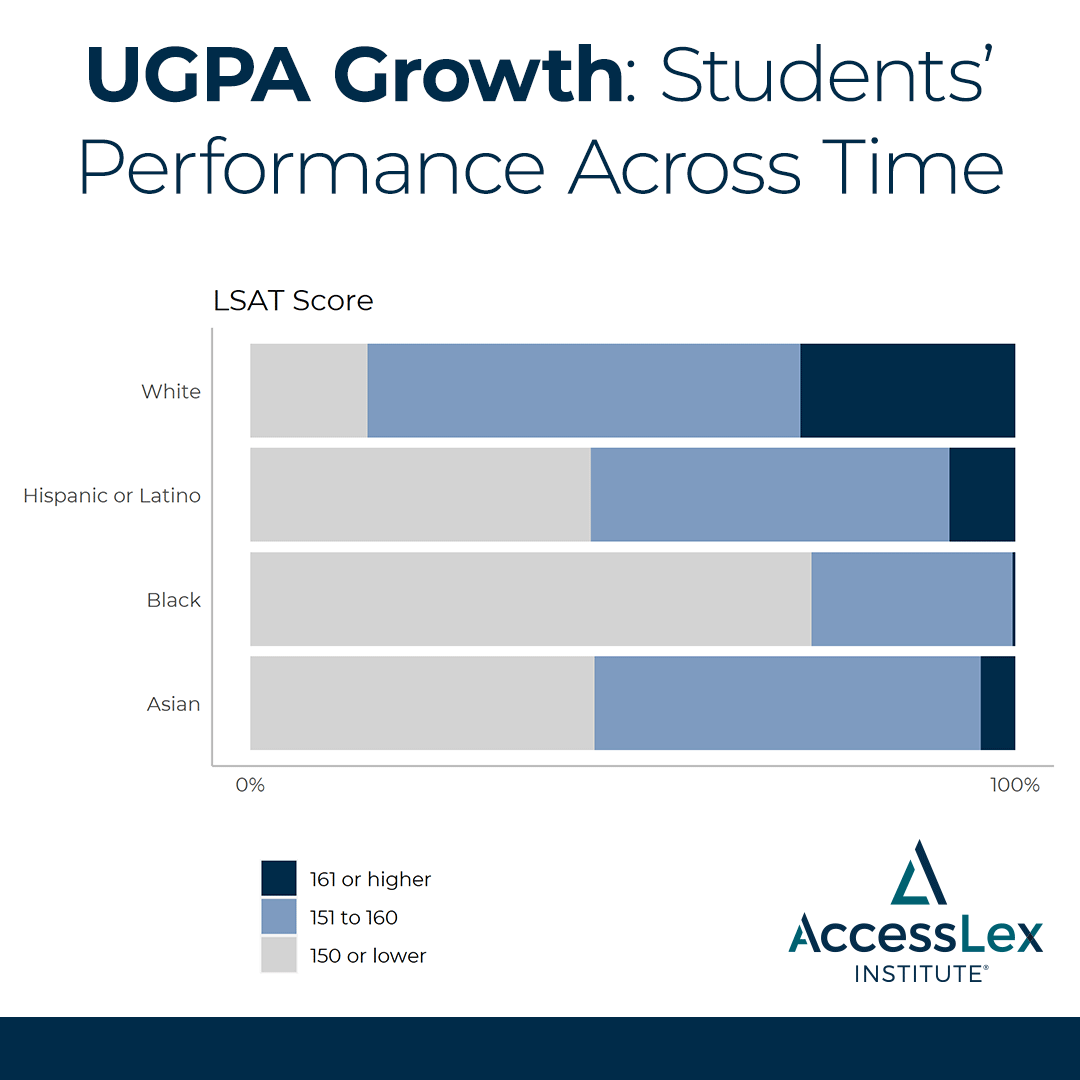Undergraduate GPA Growth: A Tool for Admitting Racially Diverse Classes
Recent research by AccessLex Institute suggests that there are new ways for law school admissions officers and committees to identify students who are likely to succeed in law school — particularly if they are interested in admitting racially diverse classes. By examining trends in applicants’ undergraduate GPAs, it is both possible and desirable to construct a fuller picture of their past academic performance and future potential.
BACKGROUND
Test scores play a dominant role in the production of new lawyers. For over a generation, aspiring attorneys have had to sit for at least two high-stakes standardized tests: the LSAT and the bar exam. The LSAT and the UBE are two of the most important limiting factors in who matriculates as a law student and who becomes licensed to practice law. This is changing, however; a number of jurisdictions are exploring alternative pathways to licensure, and more than half of all ABA-accredited law schools now accept GRE scores in their admissions processes.
The ABA Section of Legal Education and Admissions to the Bar has proposed removing the admission test requirement from its accreditation standards. This requirement is found in ABA Standard 503:
A law school shall require each applicant for admission as a first-year J.D. degree student to take a valid and reliable admission test to assist the school and the applicant in assessing the applicant’s capability of satisfactorily completing the school’s program of legal education. In making admissions decisions, a law school shall use the test results in a manner that is consistent with the current guidelines regarding proper use of the test results provided by the agency that developed the test.
The proposed revision to Standard 503 would permit law schools to go test-optional in admissions — something that a number of undergraduate institutions do already. The revision would not forbid schools from considering or requiring the submission of LSAT or GRE scores. However, this revision has been tabled in the face of considerable opposition.

Whether or not the standard is revised, concerns about standardized tests — particularly those surrounding their role in leveling the playing field — will persist. Although some assert that the LSAT and other admission tests aid in promoting diversity in law school admissions, they in fact amplify racial disparities and reduce diversity. Moreover, neither LSAT scores nor undergraduate GPA (UGPA) upon graduation are particularly strong predictors of bar exam passage — the end goal for most students pursuing a J.D.
UGPA GROWTH: STUDENTS’ PERFORMANCE ACROSS TIME
AccessLex Institute’s Bar Exam Success Analyses (BESA) seek to identify the admissions and academic factors that influence first-time bar exam performance, as well as academic performance in law school. Participating law schools provide anonymized demographic, admission, and academic data on their law school graduates to AccessLex, which then performs statistical analyses of the data at both the aggregate and individual school levels. Data from eight schools were used in the preliminary analysis summarized in this post.
Of interest here is the preliminary finding that UGPA growth is positively correlated with first-year GPA in law school (1L LGPA). We define UGPA growth as the difference between a student’s final UGPA and their first-year UGPA; higher values of UGPA growth signal greater academic improvement during college. The positive correlation between UGPA growth and 1L LGPA indicates that students with growth mindsets and a proven track record of academic effort can succeed in law school, even if they do not rise to the top when it comes to grades at graduation. In other words: it’s not where you start; it’s how you finish.

Moreover, AccessLex Institute’s BESA research shows that UGPA growth is positively correlated with LGPA growth among law school students with low first-year UGPAs. (Parallel to UGPA growth, LGPA growth is defined as the difference between LGPA upon graduation and first-semester LGPA.) A student’s UGPA at graduation, taken in isolation, may not tell the whole story about their readiness for the rigors of law school; a big jump from starting to final UGPA can be an important clue to admissions officers that a student possesses those soft skills — persistence, resilience, and determination in the face of adversity — needed to be successful. These abilities are not captured by examining an applicant’s LSAT score or final UGPA and therefore UGPA growth may distinguish applicants who have more potential than first meets the eye.
The BESA research also shows that UGPA growth is positively correlated with a student’s predicted probability of first-time bar passage. The greater the difference between a student’s final and starting UGPA, the higher that student’s predicted probability of passing the bar. Whether the outcome is bar passage or LGPA, UGPA growth has a stronger relationship than either LSAT score or final UGPA.
Finally, UGPA growth is associated with fewer differences across racial/ethnic groups than either LSAT scores or final UGPA. Although we find significant differences in LSAT scores and final UGPA values across students’ racial/ethnic backgrounds in our analysis of BESA schools, these differences are minimized or eliminated when we examine UGPA growth by race/ethnicity.
SUMMARY
Many admissions officers and committees already consider students’ performance trajectories in their undergraduate studies. AccessLex Institute’s BESA research is providing evidence to support this practice, and those who are tasked with making decisions about who is invited to matriculate to law school should avail themselves of all the information available in undergraduate transcripts. UGPA growth can be a powerful tool for identifying students who are ready to work hard and have the kind of mindset that will allow them to thrive in law school and successfully pass the bar exam the first time.
In the current moment, there are many emerging innovations in legal education, including new approaches to law school admissions, legal education and pedagogy, and the licensing of new attorneys. There is no way to be certain what law school admissions will look like ten, five, or possibly even two years from now; however, conventional wisdom and ways of doing things are no longer sufficient as the needs of law students and the legal profession evolve. Whether or not ABA Standard 503 is revised, law schools should continue to consider alternative measures of academic readiness. UGPA growth is one such measure, and it shows considerable promise.